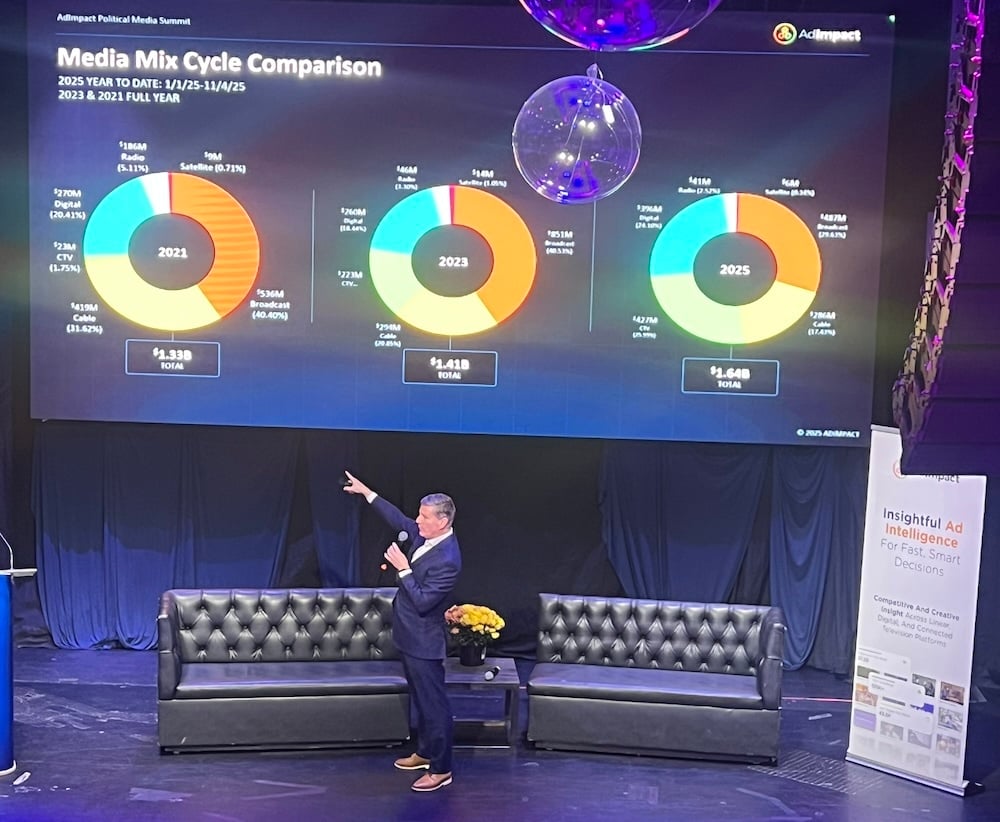Last week, we hosted our Political Media Summit, bringing together clients, colleagues and industry leaders to look at the trends, technologies and strategies shaping the future of advertising in the political space and beyond.
In addition to looking at CTV innovation and the shift towards streaming, we previewed findings looking at local media markets and our 2026 political projections report in anticipation of next year’s midterms.
In case you weren’t able to join us, we’ll share some key takeaways below.
Off-Year Trends
Total off-year spending was up 16%, fueled by spending around Proposition 50 vote in California, the Wisconsin Supreme Court race, the New York City mayoral race and gubernatorial races in Virginia and New Jersey.
In fact, spending on gubernatorial races hit $324 million in 2025, up nearly $100 million from 2021. New Jersey alone surpassed $200 million, only the second gubernatorial campaign to do so.
Downballot campaigns contests across the country saw increased spending as local races became nationalized. The New York City mayoral race and Wisconsin Supreme Court contest both drew significant attention from outside groups, which led to record-setting spending on state Supreme Court races. The $85 million output more than doubled the previous record high.
California’s Prop 50, in response to Texas’s mid-decade redistricting effort, generated $137 million in total spending. It was the second most expensive ballot proposition on record, trailing only California’s 2022 mobile gaming initiative.
As we look towards 2026, the outcome of redistricting efforts will yield significant influence in political advertisers' buying strategies.
The 2026 Landscape
Based on the redistricting efforts across the country, Republicans are projected to gain nine seats while Democrats have gained five, with the potential to bump that number to ten.
With these seats now in play and an important midterm cycle taking shape, we’re projecting spending to hit $10.8 billion for the 2025/2026 cycle.
Broadcast will continue to be a significant driver in spending, at $5.28 billion, with CTV coming in at $2.48 billion. CTV is the only media type we see rising in the 2025-2026 cycle, following a strong 2025, where spending trailed broadcast by only $60 million.
With the 1903 Group presenting findings that show that streaming reaches 33% more swing voters than linear, it’s clear that CTV will be a core segment for midterm election campaigns like it was in 2024 and 2025.
Another point of discussion around 2026 was centered around hybrid ads. The Supreme Court is expected to rule in December on a Republican-led challenge to campaign finance limits on coordinated spending between candidates and political parties.
Hybrid ads, which are purchased in conjunction with a candidate’s campaign and at the lower TV ad rate offered to candidates, have exploded in popularity, with spending in 2024 up 304% since 2018, with Republicans scaling aggressively, upping spending 57% between 2022 and 2024. If the Supreme Court shifts the rule, the $200 million spent during 2024 could go directly to campaigns, radically reshaping spending habits.
Midterms Impact on Core Advertising
Finally, we looked at how the midterms will impact core advertising so brands can adjust their strategies ahead of this year’s cycle.
In 2024, political advertising accounted for almost 5% of all spending in top markets across the U.S. In October alone, political advertising accounted for nearly 10% of television impressions, with top markets like New York and Los Angeles seeing a significant split between core and political impressions. Election advertisements also surpassed all sub-categories, taking the reins from auto insurers.
As states like California and Michigan and markets like Atlanta, Detroit and Boston come into focus for 2026, advertisers in those areas will need to plan accordingly.
For sellers, they should focus on preventing core advertisers from going dark and consider selling non-traditional television media offerings, like show sponsorships, to keep advertisers engaged.
Buyers should be prepared for increased pricing and inventory scarcity, so they should diversify buying and fund channels with solid impressions and unique audiences. TV buyers should offer a positive or emotional contrast to account for political ad fatigue, which can lead to changes in viewer attention and engagement.
These pressures make it clear that buyers need smarter, more adaptive tools for the cycle ahead. At the summit, we introduced Potomac—the next-gen political media buying platform built for this reality. Potomac automates manual work, improves accuracy, and adjusts in real time to pricing and inventory shifts. Category-specific features like Order Sync keep every revision and update aligned across buyers and sellers systems, delivering a faster, more efficient way to buy political media.
With 2026 set to be a transformative year in political and core advertising, we’re already looking forward to discussing the landscape at our next gathering! Stay tuned to our blog and socials for more updates in the coming months.
ICYMI: Recapping Our Political Media Summit









